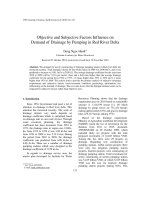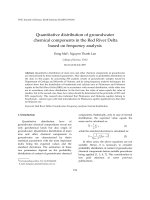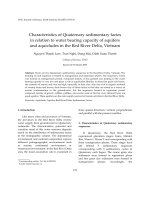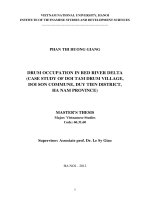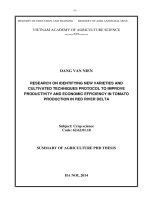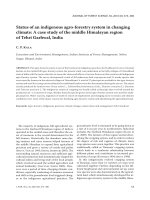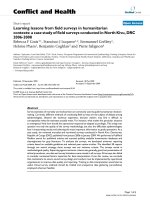Drum occupation in red river delta (case study of Doi Tam drum village, Doi Son commune, Duy Tien district, Ha Nam province) = nghề làm trống ở đồng bằng sông Hồng
Bạn đang xem bản rút gọn của tài liệu. Xem và tải ngay bản đầy đủ của tài liệu tại đây (3.83 MB, 128 trang )
VIETNAM NATIONAL UNIVERSITY, HANOI
INSTITUTE OF VIETNAMESE STUDIES AND DEVELOPMENT SCIENCES
PHAN THI HUONG GIANG
DRUM OCCUPATION IN RED RIVER DELTA
(CASE STUDY OF DOI TAM DRUM VILLAGE,
DOI SON COMMUNE, DUY TIEN DISTRICT,
HA NAM PROVINCE)
MASTER'S THESIS
Major: Vietnamese Studies
Code: 60.31.60
Supervisor: Associate prof. Dr. Le Sy Giao
HA NOI – 2012
ACKNOWLEDGEMENT
First of all, I would like to express my gratitude and deepest respect to
Assoc.Prof.Dr. Le Sy Giao, my supervisor, who enthusiastic instruct and
conveysbasic knowledge to me, as well as contributes valuable ideas to help
me complete this thesis.
I would like to sincerely thank the Management Board, the teachers, and
staff of the Institute of Vietnamese Studies and Development Sciences,
Vietnam National University. They have created the best conditions for me to
participate in the learning process and complete successfully my MA course.
I am also thankful to the People’s Committee of Doi Son commune, and
Doi Tam people for creating the best conditions for me to complete my
research trip. I would like to especially thank Mr. Dinh Van Luong (one
leader of Doi Tam village, Doi Son commune), Mr. Pham Chi Khang (one of
two experts of Doi Tam drum village) that enthusiastically provide me
information and statistic data during my fact-finding time.
I would like to express my sincere thanks to the people of Doi Son
commune for their enthusiasm in supplying me information during my field
work in these areas.
I am also thanksful to the office which I work, that is National Political
Publishing House, especially Kinh dien - Ly luan branch for creating good
conditions for me to complete this thesis.
Finally, I would like to thank my family and friends who always care,
share, motivate and encourage me.
Student
Phan Thi Huong Giang
COMMITMENT
I hereby declare that the researched results in this thesis are absolutely
honest. Information and results published in this thesis are my researching
work. If there is any shortcoming, I will bear all responsibilities before the
training unit and the law.
Student
Phan Thi Huong Giang
1
TABLE OF CONTENTS
INTRODUCTION 5
1. Reason for topic selection 5
2. Scientific and practical meaning 7
3. Objects and scope of the study 8
4. History of issue study 8
5. Studying method 9
6. Structure of the thesis 9
Chapter 1: FORMATION CONDITIONS OF DRUM PRODUCTS IN
DOI TAM VILLAGE 11
1.1. Cultural space of Doi Tam drum village 14
1.2. Drum founder 15
1.3. History of drum craft village 16
Chapter 2: COMPONENTS OF A DOI TAM DRUM 21
2.1. Productional materials 21
2.1.1. Wood 21
2.1.2. Leather 23
2.1.3. Other materials 26
2.2. Productinal tools 27
2.2.1. Sawing tools 27
2.2.2. Planing tools 28
2.2.3. Cuttingtools 30
2.2.4. The other tool 30
2.3. Productional techniques 31
2.3.1. Leathering 31
2.3.2. Drum body manufacturing 33
2.3.3. Drumhead stretching 38
2.3.4. Drum painting and maintaining 42
Chapter 3: TRADITIONAL AND MODERN DRUM PRODUCTS OF
DOI TAM VILLAGE 48
2
3.1. The traditional drum 48
3.1.1. Thunder Drums: 48
3.1.2. Large drum 50
3.1.3. “De” (base) drum 52
3.1.4. “Khau” (mouth) drum 54
3.1.5. “Bong” drum 55
3.1.6. “Manh” drum 58
3.1.7. “Chien” (fighting) drum 59
3.1.8. “Ngu loi” drum 60
3.1.9. Paper tambourine 60
3.2. Drum of the ethnic group 61
3.2.1. Acur drum 61
3.2.2. “Ghi nang” drum 61
3.2.3. “Tang sanh” drum 61
3.2.4. “ Hagunsit” drum 62
3.2.5. Paranung drum 62
3.3. Modern Drum 63
3.3.1.Jazz Drum 63
3.3.2. “Seng” drum 64
3.3.3. Meca drum 64
3.3.4. “Sai dam” drum 64
Chapter 4: DRUM PRODUCTS IN DAILY LIFE OF DOI TAM 72
4.1. Effects of drums occupation economic life of Doi Tam village 74
4.2. Effects of drum occupation on cultural life of Doi Tam village 78
4.3. Effects of drums occupation on social life Doi Tam village 78
4.4. Open issues 88
CONCLUSION 97
REFERENCES 99
LIST OF INFORMANTS 103
3
LIST OF TABLES
Table name
P
age
Table 2.1: Number of guys, knots of drums
4
0
Table 2.2: Production stages for each employee
4
4
Table 3.1: List of drum production bases in Doi Tam village
6
7
Table 3.2: List of drum production households (Doi Tam people)
in provinces
6
9
Table 4.1: Production value of drum career in economy of Doi
Tam, 2002-2004 period.
7
3
Table 4.2: Reports for achievement of officials and residents of Doi
Tam village – Doi Son commune in building new rural area model,
2009-2011 period.
7
7
4
5
INTRODUCTION
1. Reason for topic selection
Since a long time ago, drum is a mean of communication of many ethnic
groups, including the Kinh. Drum involves in many human events such as
notifying events of the village (dyke maintenance, flooding, fire, etc.),
notifying festivals, funeral, etc. Drum is very closed to children (notifying
class time, counting for lion/dragon dance team). The drum appears in many
art forms such as chèo, Chầu văn, classical drama and so on. Drum has
become an indispensable part in the spiritual life of man. It contributes to
transmit information quickly and widely.
The drum is a cultural product of each region, each ethnic group. In
Vietnam, from the very primitive material like jackfruit wood and buffalo
skin, craftsman, by their skillful and sophisticated hand, have created
complete drums of different sizes, with a sonorous sound in distant space. The
patterns, lines on the bronze and wood-frame drums profoundly represent
personal points of views and philosophy of human life. Drum sound plays an
important role in many arts (“chèo”, “hát xẩm”, water puppet, etc.), shows the
mood of both performers and audient. Drums contribute to represent the
unique character and enrich Vietnamese cultural traditions.
Over the course of historical development, nowadays, drum is still a
mean of communication, an important musical instrument in the cultural life
of the nation. Research on drum is a practical to contribute to maintaining,
reserving traditional cultural value of the nation and developing those values
in people’s lives today and tomorrow. Vietnam is a country rich in cultural
tradition – the culture is crystallized in the life and inherited and developed
over generations. Over thousands of years, the essence of traditional culture
6
remains the bright spot, the factors that make people’s vitality, a source of
great encouragement for Vietnamese people.
Craft villages reserve the essence of art and traditional techniques over
generations. That tradition has become an indispensable part and enriched the
cultural identity of Vietnam since a long time ago. Research on drum products
of Doi Tam village is also to discover the unique culture of a drum craft
village, contribute to diversifying the image of Vietnam craft villages.
In major festival including 990
th
, 1000
th
anniversary of Thang Long –
Hanoi, there was participation of great thunder drum as well as spectacular
drum teams. They are all products of craftsmen in Doi Tam village. By their
emotion, passion and talent, Doi Tam craftsmen have created masterpieces,
treasures of the nations to retransmit to future generations.
Doi Tam is not well-known for drum products in major festival but for a
famous drum craft village in the North. Doi Tam drum are present in most
localities throughout the country and involved in many aspects of people’s
lives.
Being located 60km far from the Capital and limited in development of a
craft village, the reputation of Doi Tam village has not been known yet.
Research materials for products of the village are scarce as well.
For the desire of discovering products of Doi Tam village from
formation, material, structure and classification, the writer wants to get closer
access to the life of a craft village in northern delta. Also, the writer wants to
go further to find out shortcomings and disadvantages of the village and
propose solution to make the village and its products more complete and
public and to have closer look at the reality of “development process of
human culture is a continuous succession. What remains today and people
determine to preserve is the unique of national culture".
7
2. Scientific and practical meaning
* Scientific meaning
Presently, there are not many writings about Doi Tam village,
particularly, general study on the village. The project of “drum occupation in
Red River delta (case study of Doi Dam drum village, Doi Son commune,
Duy Tien district, Ha Nam province)” will contribute to enrich the materials
sources on the village. The drum product of the village will be systematically
presented from formation conditions and factors, type of drums to its meaning
to people’s lives in the Doi Tam village. Readers will have scientific and
comprehensive view on the products of the villages not only in the past but in
the present.
* Practical meaning
Doi Tam drum craft village really became famous after making thunder
drum in 990th anniversary of Thang Long - Hanoi. Since then, Doi Tam
drums have been present in many large or small-scale events of the country as
well as people’s lives in other regions. The researches project of “drum
occupation in Red River delta (case study of Doi Dam drum village, Doi Son
commune, Duy Tien district, Ha Nam province)” expect to contribute to
raising the fame for the products of the village. Studying the products of Doi
Tam village, the writer also has closer approach to the village life in all
aspects of economy, society and culture, to see not only the achievements but
also shortcomings and short-term limitation of the village. Accordingly, local
authorities and people will have specific orientation and solutions for future
development of the village to make its drums popular products in the country
and the world.
3. Purpose of the study
8
1-Find out drum products of Doi Tam village from tradition to modern
type.
2-Study the formation condition of drum products, factors to create
drum products and their impacts on people’s lives in Doi Tam village.
3- Have holistic view of Doi Tam drum craft village in term of
economy, culture and society, etc.
4. Objects and scope of the study
* Objects of the study: studied objects of the thesis are drum products
of Doi Tam Craft village – a typical drum making village in Red River delta.
The writer is going to focus on formation conditions, factors of drums, types
of drums and its meaning in the lives of Doi Tam people.
* Scope of the study: Thesis on traditional and modern products of Doi
Tam village (Doi Son commune, Duy Tien district, Ha Nam province), in
which the thesis focuses on studying traditional products, particularly actual
status and solutions for current development of Doi Tam village.
4. History of issue study
The products of Doi Tam drum craft village have important meaning in
people’s lives, but have not been satisfactorily studied and understood. There
is hardly any intensive document on drum of the village. The drums are only
mentioned to in general in Traditional craft village of Vietnam book by Pham
Con Son, the reader know the name, products and formation time of the craft
village.
Products of Doi Tam is mentioned much in internet journals such as Ha
Nam Portal, marketing websites of enterprises in Doi Tam or e-journals
including vietbao.vn (Article: Doi Tam drum craft village), zing.vn (Article:
strange customs in Doi Tam drum craft village), anninhthudo.vn (Article: Doi
Tam drum craft village by Thanh Phuong), baomoi.com (Article: Doi Tam
drum craft village), baodatviet.vn (Article: Doi Tam – a thousand-year drum
9
village). However, above articles are mostly report mentioning to most
common information about Doi Tam drum craft village such as origin of
formation, materials, processes of producing drums and the most typical
craftsman and drum products of the village (the drum served in 990
th
, and
1000
th
year anniversary of Thang Long – Hanoi).
There is a very careful and meticulous study on Doi Tam drum village,
the Final Project of “Drum manufacturing occupation in Doi Tam village, Doi
Son commune, Duy Tien district, Ha Nam province” by Ms. Nguyen Thu
Huong. The thesis scientifically and specifically described the drum village:
formation, the founder, production processes and its effects on aspects of
people’s lives in Doi Tam. The author; however, focusing in studying
traditional as well as modern products of Doi Tam village.
Basing on materials of culture books, practical experience and materials
from internet, the writer has selected, systemize them to present her specific
idea in the thesis of “Drum occupation in red river delta (case study of Doi
Tam drum village, Doi Son commune, Duy Tien district, Ha Nam province)”
5. Studying method
- Historical method: Study origin of Doi Tam drums and changes in
technique, design of products in the past and at present.
- Ethnological fieldwork method: Base on practical observation in Doi
Tam village, interview with some craftsmen, owners of production bases, and
the writer has understood specifically in details production stages of different
drum products. The trips also help the writer to have more precious
experiment about social life of Doi Tam village now and before.
6. Structure of the thesis
Besides the introduction, conclusion, the thesis will include 4 chapters:
- Chapter 1: Formation conditions of drum products in Doi Tam village
- Chapter 2: Components of a Doi Tam drum
- Chapter 3: Traditional and modern drum products of Doi Tam village
10
- Chapter 4: Drum products in daily life of Doi Tam
11
Chapter 1: FORMATION CONDITIONS OF DRUM PRODUCTS IN
DOI TAM VILLAGE
During the historical development, the appearance of craft is associated
with the division of social labour, the cause for disintegration of primitive
communal system as well as for appearance of state, and changes the
primitive communal system into a higher socio-economical form, that is
division of social labour. History of ancient society experienced three times of
social labour division, including: The first time, breeding separated from
cultivation; the second time, craft separated from agriculture; the third time,
commerce appeared. After the first labour division, both breeding and
cultivation developed with the application of breeding into cultivation. The
society has certain changes; there appeared private ownership, the society is
divided into slave and slave holder class.
Metal was discovered and metal tools helped to increase labour
productivity. The metal manufacture, textile, ceramic industries and
agricultural product process are more and more developed. As the result, the
craft is separated from the farming to become an independent occupation.
Since then, various crafts were formed and developed.
The appearance of many professions in production has generated demand
for goods exchange in society. The development of commodity production
leads to the development of trade which was later separated as an independent
sector. This labour division made profound changes in society with the advent
of merchant class.
Thus, the craft has been formed since ancient time with the division of
social labour and the establishment of craft villages over the time
development.
12
Craft village is a cultural and socio-economic environment. Craft village
in Vietnamese is a term that refers to communities, mainly in outskirts and
rural areas, a joint production of traditional craft products of the same type.
Craft village is often characterized by the unique, typical and not only
economic but also cultural tradition. Findings of archeology and the historical
evidence have proven that Vietnam craft villages were born thousands of
years ago. Together with the development of agriculture, many craft careers
were formed in rural areas of Vietnam. Initially, it was extra work at free time
to make necessary items tools for daily life; it developed into demand of
commodity exchange and seeking for extra income outside agriculture. As
agricultural characteristic and inter-village, inter-commune relation of
Vietnam, these crafts were selected and easily developed from individual to
family size. Gradually, craft villages spreaded among craftsmen, families and
developed throughout the villages or neighbor villages in the principle of
handing down. For different benefits of craft, there appeared separations
among crafts, which brought much benefit strongly developed whereas low-
efficiency or inconsistent crafts gradually disappeared.
Be one of musical instruments, percussion instrument contributes to
create the uniqueness of traditional music. The sound of percussion
instrument make people think of working tools closed to people from
primitive time such as the clapping, stamping, crashing of tree branches or
stone to each other to threaten the wild animals while hunting or in the
happiness after returning from hunting activities. It might be the rice-
pounding pestle associated with agricultural civilization. The beats created the
primitive sounds and rhythm for traditional musical instrument.
Drum is a musical instrument in percussion instrument, it decides the
rhythm of the music; it diversifies and keep the rhythm for the music. For
13
many songs need only drum. Drum is the earliest musical instrument. From
primitive time, the man learned to use drum to make the fist sounds with
rhythm in the history. In the past, drum was just an empty box covered with
skin and spreaded hard to make sound. Since then, drum was being used in
festivals of ethnic groups and to encourage the troops before the battle as well
as in training.
A complete set of drums includes: large drum responsible for keeping
main rhythm in the set. Other drums are called small drum, they have
different external structure as well as low or moderate tune; it also depends on
which drum the drummer wants to play to make a complete song with the
help of other musical instrument.
Drum is musical instrument of many parts of the world such as Japan,
China, Nepal, Mongolia, India, Indonesia, Canada, Kenya, Peru, and Ecuador.
In general, the drums called Denden-daiko in Japanese are the toys for children and
also the musical instrument of monks in Buddhism in Nepal, Mongolia and India.
Materials of drums are different from each place; it depends on natural
conditions of each country. In Japan, drums are made of wood and paper, but
in other countries, animal skin is used to cover the drum surface. In china,
drum surface is covered by plastic. In Kenya, cement tools are used to beat
the drum. Decoration in drum surface is diversified and attractive, zebra is
seen in the drums in Kenya and tropical bird is in drums in Ecuador. Drums
make unique marker reflecting culture of each country.
In Vietnam, a tropical country with rich cultural tradition, drums have
had close relation with people since ancient time. Through the ups and downs
of history, drums increasingly play an important role in the cultural life of the
nation. Drums appeared in every large-scale or small-scale cultural event of
the country and participated in many activities, important milestones in the
14
life of everyone. Speaking of space, it is impossible for us not to mention to
Doi Tam drum village – a craft village well-known not only in northern delta
but also all over the country.
1.1. Cultural space of Doi Tam drum village
Doi Tam or Giap Ba, Doi Son commune, Duy Tien district, Ha Nam
province is a separate administrative unit established during the separation of
villages. It is one of three villages: Doi Son, Doi Nhat and Doi Nhi or Giap
Nhat, Giap Nhi and Giap Ba.
Doi Son is located in the South East of Duy Tien district which includes
8 villages: Doi Tin, Doi Nhat, Doi Trung, Doi Linh, Doi Nhi, Doi Tam, Hoa
Thinh and Son Ha. Doi Tam village is next to the foot of Doi mountain,
bordering to Mieu village and Noi village to the West, Doi Nhi and Doi Tin
villages to the North and Doi Nhat to the South.
In the East, Chau River originates from Nhue River running through Gie
bridge to the center of Duy Tien and Phu Ly districts and is 27km long, 200m
wide in average, the largest section in Phu Ly is 350m, the narrowest section
in Hoa Mac is 180m, 3m deep in average, 400m far from Doi mountain.
Doi is a sacred mountain; name in Han script is “Long Doi Son” (Dragon
mountain). Observed from the western foot of the mountain, Doi Mountain
include three tops, two side protruding tops are like a two-handed seat, the
central top is coat-alike. At the foot of the mountain there is a well deep into
the mountain like dragon’s mouth. Observed from the North, the mountain
looks like an elephant. So, "Doi" word includes the "elephant symbol" in the
right. From the mountain the view covers the plains, green corn, potato fields
and Chau Giang River running sinuously.
There are 9 natural wells near Doi River. According to ancient notions,
this is the land of the king, thus there are a lot of brick Han tombs. Recently,
15
local people also found iron-wood piles of 2m length, 30cm diameter plugged
around these tombs to avoid erosion by water.
By now, Doi Son is archeological site where many integral skulls of
ancient people at Dong Son civilization 2000 years ago were found. Thus, via
measurement and study, archeologists have defined the gender, age and
ethnics of Doi Son ancient people, from15 - 17 to 40 – 50 years old. In
remains found, there was also southern mongoloid peoples and Southeast
Asia peoples (Malayo Polynesian).
1.2. Drum founder
Only Doi Tam village in Doi Son commune has drum craft. Doi Tam
locates in the Northwest of Doi Mountain. Center of the village is an ancient
communal house worshiping tutelary gods – Two founders of drum draft.
Founder is a sacred concept in the spiritual life of each craftsman. It is
taught by our ancestors that “everyone has a job though poor or rich”. A job is
created for the demand of living, and aesthetic. Any job starts by the
invention, creativeness of one or many people who are called the founder.
Back to ancient time, people of Dong Son culture knew how to cast
copper drums with sophisticated techniques (2500 years ago). So, when was
wood drum created and by whom?
In the myth of local people, drum craft was formed 1000 years ago. It
comes from ancient time that one day while two brother of Nguyen family are
passing Doi mountainous area they saw many beautiful jackfruit trees so they
decided to choose this place for settlement and handed down drum career.
The older brother Nguyen Duc Nang and the younger brother Nguyen Duc
Dat chose strong young and skillful people to teach them drum career. Until
one day, they were informed that the King Le Dai Hanh would hold plaughing
16
festival here, two brother decided to make a special drum to welcome the
king. That drum was completed in spring of 987.
Other myth says that: Drum career has existed for very long time, no one
remembers. They only know that Mr.Nguyen Quy Cong or Phuc Nang in Han
script is now being worshiped as the founder and founder’s grave is built as
imperial tomb in the eastern side of Doi Mountain.
It is said by People in Doi Tam that, when the King Ly Cong Uan was
moving Hoa Lu capital to Thang Long and passing Chau River, Doi Mountain
he heard very beautiful drum sound from Doi Tam village and allowed local
people to come and settle in the capital, thus the drum street is formed and
widely developed. The drum career from Doi Tam village has been well
known since then.
In the notion of people, they believe that there is virtual relationship
between the drum founder and them. In the heaven, the gods will support
them to overcome difficulties for survival and development. The worshiping
of the founder who though is real or legendary characters is aimed at
confirming and honoring that career. On anniversary of the founder’s death –
January 07
th
each year is the actual evidence proving the living of drum career
in the lives of local people.
1.3. History of drum craft village
Before the Queen mother Y Lan and the king Ly Nhan Tong came Doi
Son to build Long Doi Son pagoda (1118), Doi Tam drum village had been
over 200 years old.
During feudal time, the drum career of the village was undeveloped.
Drums were used only for festival or emergency of the village such as
patrolling, dyke maintenance, etc. Doi Tam craftsman had to carry furniture,
clothes and buffalo skin strolling to other places for making drums. Where
17
there was demand for drum, they stopped, sought for material, sawed, planed
wood to make drums on the spot.
In subsidy period, drum craft of the village developed at wider scale but
still fragmented. During this period there is more drum demand for schools,
children and cooperatives. Drums become the work signal for people in the
cooperatives. Lives of farmers are most realistically portrayed in poem of the
Poet To Huu "All the time in the village is full of drum beat". In the morning,
drum sound announce the work time, at noon or afternoon, it announced break
time. People worked and took a rest in compliance with drum sound. This
period in Doi Tam drum career development at individual scale. Materials for
drum are scarce as buffalo skin is mainly used for defense or producing beam
pier, footwear for soldiers.
At that time, the Government prevented superstition, Doi Tam craftsmen,
though they already had bicycles to go and make drums for other
communities but they had to make the drums on a hill and could not try the
drums after making as they might get arrested.
Boys at Doi Tam village were taught how to make small drums since
they were at 12 or 13 years old and they would go along with their father and
brothers to make big drums. Thunder drums could be made by healthy and
skillful men only. Doi Tam craftsmen could make any type of drums: drums
for temples, drums for traditional operetta, drums for schools, and drums for
mid-autumn festival, etc. In the past, craftsmen could make up to twenty
thousand drums and sold everywhere.
Innovation time brought back many changes to Doi Tam drum making
village. People got interested in their spiritual lives, pagodas and temples
were built everywhere leading to the demand for drums. Especially, after the
Government restricted people from setting off firecrackers, drums were more
18
and more common used. In the past, firecrackers were used in most of the
events, now it is the drums to be used.
Over the thousands of years, Doi Tam villagers still keep and have been
developing their traditional industry. Doi Tam drum making village became
famous of their traditional industry after making the drums for Thang Long -
Hanoi 990 years event (in 2000). In October, 2004, Ha Nam granted a
certificate recognizing Doi Tam drum making village as a traditional craft
village. And in November, 2007, the village was granted with the credit of
“Typical Craft Village of Vietnam” by Vietnam Association of Craft Villages.
Doi Tam drum making village managed to keep their traditional industry
over the economic depreciation period by helping each other among the
villagers. Nowadays, Doi Tam craftsmen are still trying to keep their
ancestor’s traditional industry. Many families are living on drum making and
are having a better life because of the industry. Not only good at making
drums, Doi Tam villagers are also very good at drumming. Not sure whether
there is another female drummer team like in Doi Tam. They are not only
performing on their traditional carnival on January 7 in lunar calendar every
year, they would be willing to go wherever they are invited to. On those
events, hundreds of drums at various sizes would go along with their
drummers to anywhere.
Regulations for drums and for the industry
There are regulations either in a separated written document or in village
convention of each village for most of the long-standing craft villages.
Documents about traditional industry are called “vow”. These regulations are
descended from generation to generation and are required to be strictly
followed by family members or craftsmen of the villages.
19
The regulations for Doi Tam drum making village regulated strictly that:
the secret of making drums are handed down within family and drum makers.
People who are going out are not allowed to discrete the secret; the secret
would not be handed down to a girl who is going to get married to a man from
another village. The state-of-art (secret) is handed down to sons, grandsons,
and daughter-in-law only. And it can also be handed down to a son-in-law
who is also living in the same village.
The handing down of the secret is performed in a way: a grandfather
hands down to a father and the father hands down to his sons or nephews.
Like all other traditional handicrafts, Doi Tam craftsmen are taught by
showing how to work and ask for practicing. Learning by practicing is the
main idea, not the theory.
There is a curse in village that: If a family discretes the know-how-to
secret to the outside, they will not be helped out by “not letting to eat, not
helping to burry”, and “the family will be cursed for 3 generations”. The
village’s secret is for the villagers only. The curse is embedded in every Doi
Tam villagers’ memory of all generations.
Wherever they go, Doi Tam craftsmen still follow their regulations. The
know-how-to secret is kept within the families. Even the chief drum maker
would not let his assistant know all the skills. In the past, the formula for
making the drum rim, and taking measurements, etc., are kept in secret, only
the chief worker knows.
Though the industry is very competitive, the relationship among the
craftsmen is not affected, especially among craftsmen who have the same
mentor. There is also an article in the regulation saying that: If a worker has a
new contract and there is another worker in his team, there are two options. If
the other worker already removed the drumhead, the one who has the contract
20
would offer that worker a meal before letting him off the work. And the other
worker would not ask for a share in the work. If the other worker is making a
bargain with the one who orders, both the craftsmen will cooperate to make
the drum and will share the pay. If the other worker does not agree with the
bargaining price and another worker can work with that price (lower price),
he can have the contract.
Mutual assistance is also typical in the drum making industry. A working
who is making a drum, but runs out of material, can borrow materials, and
even helpers, from another team.
There are some forbidden in the process of making drums such as women
are not allowed to climb onto the drums, especially the drums for worship
purpose. Men are not allowed to have sex for 1 week before and during the
making of drums to keep the drums sound good and loud enough.
Conclusion 1
Thus, in the point of cultural origin, Doi Tam drum craft village locates
in the hollow land of Red River delta with the history of 1000 years. Legend
has it that the founder of this craft was Mr. Nguyen Duc Nang and his grave
was built in the eastern side of Doi Mountain. January 7th of each year is the
death anniversary as well as the important festival of the village. Over stages
of development: difficult feudal, undeveloped subsidy time and widely and
strongly developed transitional time, by now, Doi Tam village has produced
drums serving people nation wide.
21
Chapter 2: COMPONENTS OF A DOI TAM DRUM
2.1. Productional materials
Doi Tam drum quality is preserved through the generations because the
work man worked carefully, creative with basic techniques steps such as skin
doing, the face of the drum doing, drum trap. To do the face of the drum, they
choose the female buff. It is soaked and deodorized then dried.
The out side skin is used to do big drum, the under skin is used to do
the small drum. Wood to do the drum is soft, flexible, many songs were cut
into pieces then crushed. Depending on the size of the drums, the worker
divide how many pieces of chips to do the drum, and plastic curvature of the
particle to be.
Calculated at the drum graft to fit snugly. The most important step is
the drum trap. When the crank circle buffalo skin tension on the many kinds
of the drum all sizes, competent workers inspect the sound, when they are
satisfied, the key to nailing drum fixed to the body. The drum sound quality
depends on the skill and standard of the workers…
2.1.1. Wood
First of all, timber to do the drum that is jack fruit wood. This wood is
yellow, smooth plastic, wood grain is very small and very soft, rarely warped
by the effects of weather, degree of the heat climate, little vermin. These
properties are very essential for doing the drums as well as for the
convenience of worshiping and othe appliances ( foot candles, incense tubes,
trays…). Jack wood also have one other characteristic is the be likely to enjoy
music, amplified. When creating a pair of cylindrucal sealed container, this
wood become a powerful and standard thing.
22
Jack fruit wood consists of three parts: the outer shell of wood is rough,
dark brown, the inside of the timber class – divided into two categories: the
first layer of jack fruit wood, called wood “feeling” in white and divivory to
resistance weaker the the inner layer, inner layers of jack fruit wood called
“core” has bright, that is very yellow.
Drum “bare core” meetings (full wood core) is the truth ideal, because
the wood core strong, fared and “older” than should not suffer, with srand
great force. Doing the drum, the “bare core” (full wood core) is the best ideal,
because the wood core strong, hard and “older” than should not suffer, with
srand great force.
Days ago, people in other places often carry wood to Doi Tam village
to sale, or the workers go to any where often take saw, plane to do the drum is
place as required, taking wood at the place. Now jack wood is rare the wood
in the village is not enough to provide to do the drum. Doi Tam workers
usually order or purchase processed jack fruit wood in the different place,
sawn chips available at various facilities in the areas of the other provinces by
the Doi Tam, that submitted there. Northern areas now jack fruit wood are
very rare, Doi Tam workers rally to buy wood in the Thanh Hoa, Nghe An,
Ha Tinh, Hue, Da Nang…, the people of ethnic minorities, bored areas of Ho
Chi Minh trail or in the central highlands. People come to consider it carefully
and the choose to buy timber for transport or processing, cut it to chip in on
the light transport. In the area of provinces such Quang Nam, Da Nang has
many settings in the produtions of Doi Tam drum frame to establish the
business in which chips are often sent timber vack to the village. Exerperience
of some elderly artisand in Doi Tam village, the experince of some elderly
artisans in Doi Tam village, the jack fruit trees live for over 50 years, its new
wood called the old and thick. Jack live in hilly land have the timber is better


